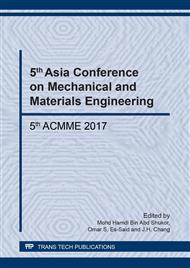[1]
E.P. Kearsley and P.J. Wainwright: Cement and Concrete Research Vol. 31 (2001), pp.105-112.
Google Scholar
[2]
K.S. Wang, I.J. Chiou, C.H. Chen, and D. Wang: Construction and Building Materials Vol. 19 (2005), pp.627-633.
Google Scholar
[3]
K. Jitchaiyaphum, T. Sinsiri, and P. Chindaprasirt: Procedia Engineering Vol. 14 (2011), pp.1157-1164.
DOI: 10.1016/j.proeng.2011.07.145
Google Scholar
[4]
J. Torkaman, A. Ashori, and A.S. Momtazi: Construction and Building Materials Vol. 50 (2014), pp.432-436.
Google Scholar
[5]
N.A. Memon, S.R. Sumani, and M. Ramli: Journal of Applied Sciences Vol. 6 (2006), pp.1560-1565.
Google Scholar
[6]
C.L. Hwang and T.P. Huynh: Construction and Building Materials Vol. 93 (2015), pp.335-341.
Google Scholar
[7]
B. Karthikeyan, R. Selvaraj, and S. Saravanan: International Journal of Earth Sciences and Engineering Vol. 8 (2015), pp.115-119.
Google Scholar
[8]
Q.L. Yu, P. Spiesz, and H.J.H. Brouwers: Cement & Concrete Composites Vol. 61 (2015), pp.18-28.
Google Scholar
[9]
K.S. Wang, I.J. Chiou, C.H. Chen, and D. Wang: Construction and Building Materials Vol. 19 (2005), pp.627-633.
Google Scholar
[10]
X. Zhao, S.K. Lim, C.S. Tan, B. Li, T.C. Ling, R.Q. Huang, and Q.Y. Wang: Materials Vol. 8 (2015), pp.462-473.
Google Scholar
[11]
M.M. Saleh: International Journal of Conservation Science Vol. 4 (2013), pp.255-270.
Google Scholar
[12]
ASTM C109. In: Annual book of ASTM standards, 04(01) (2016).
Google Scholar
[13]
ASTM C567. In: Annual book of ASTM standards, 04(02) (2014).
Google Scholar
[14]
H. Li, D.H. Han, H. Yuan, X. Qin, and L.X. Zhao: Geophysics Vol. 81 (2016), p. D83-D90.
Google Scholar
[15]
M.Y.J. Liu, U.J. Alengaram, M.Z. Jumaat, and K.H. Mo: Energy and Buildings Vol. 72 (2014), pp.238-245.
Google Scholar
[16]
B. Beeralingegowda, and V.D. Gundakalle: International Journal of Innovative Research in Science, Engineering and Technology Vol. 2 (2013), pp.4996-4502.
Google Scholar
[17]
P. Thongsanitgarn, W. Wongkeo, S. Sinthupinyo, and A. Chaipanich, in: TIChE International Conference (2011) at Hatyai, Songkhla, Thailand.
Google Scholar
[18]
E.P. Kearsley and P.J. Wainwright: Cement and Concrete Research Vol. 32 (2002), pp.233-239.
Google Scholar
[19]
R. Gül, E. Okuyucu, İ. Türkmen, and A.C. Aydin: Materials Letters Vol. 61 (2007), pp.5145-5149.
DOI: 10.1016/j.matlet.2007.04.050
Google Scholar


